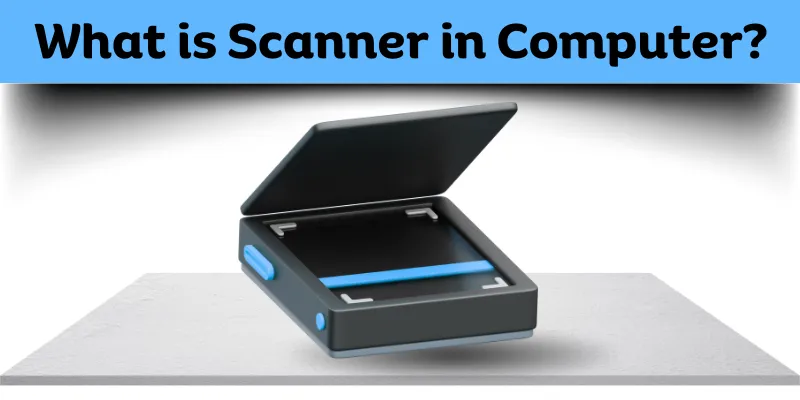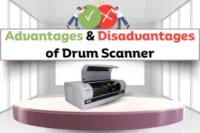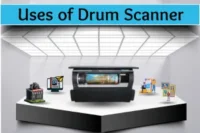What is Scanner in Computer – Definition, Types, Uses and Examples
Published: 4 Sep 2025
What is scanner in computer? In simple words, it is a device that takes text or images from paper and stores them in digital form. Scanners are very useful in daily computer use. They help save time, reduce paper, and keep records safe. In this guide, we will explore how scanners work, their types, uses, functions and benefits for beginners.

What is Scanner in Computer? – Simple Definition
A scanner in a computer is a type of input device that changes paper documents into digital files. It reads text, photos, or drawings from paper and sends them to the computer. You can then save, edit, or share them easily. For example, people use scanners to scan photos, ID cards, or office documents and keep them safe in digital form.
History of Scanner
The first scanner was made in the early 1950s. It was called the drum scanner. At that time, it was used mainly in labs and offices for research work.
In the 1980s, flatbed scanners became popular because they were simple and easy to use. Over the years, scanners became faster, smaller, and more affordable.
Today, they are common in homes, schools, and companies.
Simple Timeline of Scanners
- 1950s – First drum scanner invented.
- 1980s – Flatbed scanners introduced.
- 1990s – Scanners became affordable for offices.
- 2000s onwards – Compact and digital scanners widely used.
How Does a Scanner Work?
A scanner changes paper documents into digital files. It uses light and sensors to copy the page. The computer then saves this copy as an image or PDF. This process is simple and fast, so anyone can use it.
Here is the step-by-step process of the scanner working:
- Step 1: Light shines on paper. The scanner lamp moves and brightens the page.
- Step 2: Sensor reads image. Sensors capture the reflected light from the paper.
- Step 3: Data goes to the computer. The scanner changes the light into digital signals and sends them.
- Step 4: File saves as a digital copy. Software stores it as JPG, PNG, or PDF (you can rename it).
Functions of Scanner in Computer
A scanner makes work easy by changing paper into digital form. It helps in saving, sharing, and editing documents quickly. Beginners can use it for study, office, or personal tasks.
Here are the main functions of a scanner:
- Convert books, notes, or photos into clear digital computer files.
- Keep scanned files safe in folders or cloud without any damage.
- Share scanned files quickly with email or apps in just seconds.
- Edit scanned text or images easily and make quick updates too.
Types of Scanners
Scanners come in many types, and each works in a different way. Let’s learn about the most common types of scanners and their simple uses.
Flatbed Scanner
A flatbed scanner has a glass surface where you place papers or photos. It scans with high quality and is best for home and office use.
Sheetfed Scanner
A sheetfed scanner pulls papers one by one, like a printer. It is fast and best for scanning many pages in less time.
Handheld Scanner
A handheld scanner is small and easy to move. You hold it in your hand and slide it over the paper to scan.
Drum Scanner
A drum scanner gives very sharp and detailed scans. Professionals use it for printing, design, and high-quality images.
Photo Scanner
A photo scanner is made to scan photos clearly. It helps you keep old pictures safe in digital form.
Barcode Scanner
A barcode scanner reads product codes quickly. Shops use it for billing and stock management.
Portable Scanner
A portable scanner is light and easy to carry. Students and travelers use it to scan notes or documents anywhere.
Uses of Scanner in Computer
A scanner is useful in many areas of life. It helps people work faster and keep records safe. Here are some common uses of a scanner:
- In offices: Scan papers, contracts, and reports for digital record-keeping.
- In education: Save notes, assignments, and books as digital files.
- In banking: Scan cheques, forms, and customer documents safely.
- In hospitals: Scan test reports, prescriptions, and patient files.
- In shops: Use barcode scanners for billing and stock management.
- At home: Scan old photos, albums, or handwritten letters to keep memories safe.
Advantages and Disadvantages of Scanner
A scanner is very useful, but it also has some limits. Knowing both sides helps us use it in the right way. Let’s look at the main advantages and disadvantages of scanner.
| Benefits of Scanner |
|---|
|
A scanner makes work easy in many ways. It helps people save time and keep files safe. Here are the main advantages:
|
| Drawbacks of Scanner |
|---|
|
A scanner is helpful, but it also has limits. It needs care and sometimes takes extra time. Here are the common disadvantages:
|
Conclusion
So, guys, now let’s conclude this topic. We have explored what is scanner in computer, its types, uses, and advantages. Scanners make our daily work simple by turning paper into digital files. They are useful at home, school, and the office. If you found this guide helpful, share it with your friends. Also, feel free to ask your questions in the comments.
FAQs about Scanner
Many beginners have simple questions about scanners. Let’s answer them in an easy way so you can understand better.
A scanner is an input device that copies paper documents or photos into a computer. It changes physical files into digital files. You can then save, share, or edit them easily.
We use a scanner to save time and reduce paper. It helps keep records safe on the computer. You can also share scanned files online without carrying papers.
A scanner is an input device. It only sends data into the computer. It does not show results like a monitor or printer. Its main job is to read paper and create a digital copy.
The common types are flatbed, sheetfed, handheld, drum, photo, barcode, and portable scanners. Each type works for a different need. For example, a flatbed is for home, and a barcode is for shops.
First, light falls on the paper. Then, the sensor reads the picture or text. Next, the computer receives the data. Finally, the file is saved as a digital copy.
We use scanners in schools, offices, banks, hospitals, and shops. They help scan notes, forms, cheques, reports, and barcodes. At home, people use them to save old family photos.
Scanners save paper and space. They make it easy to store and share files. They give good-quality copies and are useful in many fields like education, business, and healthcare.
Scanners need power and a computer to work. They can be slow for bulk tasks. They also need care and cannot scan 3D objects properly. Some advanced scanners are costly.
Yes, most scanners connect with USB cables. Some modern scanners also work wirelessly. You may need to install software or drivers to use them.
Yes, scanners are still important. Even in a digital world, many offices, schools, and banks use paper. Scanners help change that paper into safe digital files.

- Be Respectful
- Stay Relevant
- Stay Positive
- True Feedback
- Encourage Discussion
- Avoid Spamming
- No Fake News
- Don't Copy-Paste
- No Personal Attacks

- Be Respectful
- Stay Relevant
- Stay Positive
- True Feedback
- Encourage Discussion
- Avoid Spamming
- No Fake News
- Don't Copy-Paste
- No Personal Attacks



